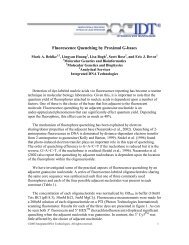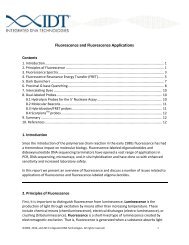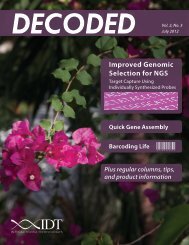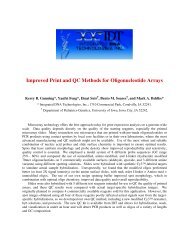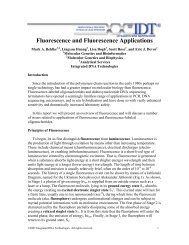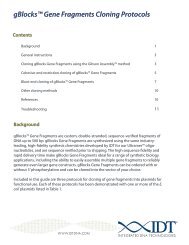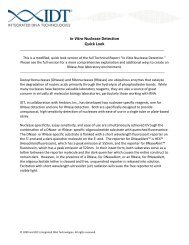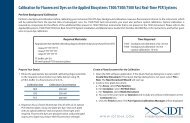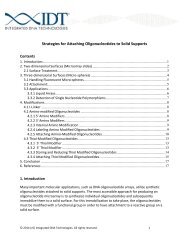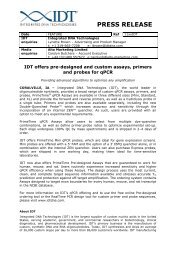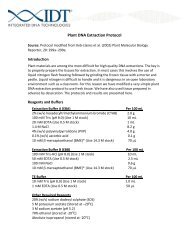Chemical Synthesis of Oligonucleotides - Integrated DNA ...
Chemical Synthesis of Oligonucleotides - Integrated DNA ...
Chemical Synthesis of Oligonucleotides - Integrated DNA ...
Create successful ePaper yourself
Turn your PDF publications into a flip-book with our unique Google optimized e-Paper software.
3.3 CappingWhile the increased efficiency afforded by the advent <strong>of</strong> tetrazole phosphoramiditeintermediatecoupling was a major advance in oligonucleotide synthesis, it was still a chemicalprocess and so had a finite failure rate. A coupling failure results when an oligonucleotideretains a reactive hydroxyl group on its 5’-most end. If this were to remain freely reactive, itwould be able to couple in the next round and would result in a missing base in the synthesis.Thus, coupling failures must be removed from further participation in the synthesis. This isaccomplished by adding an acetylating reagent composed <strong>of</strong> acetic anhydride and N-methylimidazole. This reagent reacts only with free hydroxyl groups to irreversibly cap theoligonucleotides in which coupling failed.3.4 StabilizationOnce the capping step is accomplished, the last step in the cycle is oxidation which stabilizesthe phosphate linkage between the growing oligonucleotide chain and the most recently addedbase. The phosphate linkage between the first and second base must be stabilized by makingthe phosphate group pentavalent. This is achieved by adding iodine and water which leads tothe oxidation <strong>of</strong> the phosphite into phosphate leaving the phospho-triester bond stabilized.3.5 Cleavage, Detritylation, DeprotectionThis cycle is repeated for each nucleotide in the sequence. At the end <strong>of</strong> the synthesis theoligonucleotide exists as, for example, a 25-mer with the 3’ end still attached to the CPG andthe 5’ end protected with a trityl group. In addition, protecting groups remain on three <strong>of</strong> thefour bases to maintain the integrity <strong>of</strong> the ring structures <strong>of</strong> the bases. The protecting groupsare benzoyl on A and C and N-2-isobutyryl on G (figure 6). Thymidine needs no protectinggroup. The completed synthesis is detritylated and then cleaved <strong>of</strong>f the CPG leaving a hydroxylon both the 3’ and 5’ ends. At this point the oligo (base and phosphate) is deprotected by basehydrolysis using ammonium hydroxide at high temperature. The final product is a functionalsingle-stranded <strong>DNA</strong> molecule.Figure 6. Structures <strong>of</strong> the four nucleoside phosphoramidite monomers. The benzoyl andisobutyryl protecting groups on the A, C, and G monomers are shown.3.6 DesaltingAlthough deprotection removes the protecting groups, they remain with the oligonucleotide asorganic salts. The process <strong>of</strong> removing these contaminants is called desalting.©2005, 2010, and 2011 <strong>Integrated</strong> <strong>DNA</strong> Technologies. All rights reserved. 6



